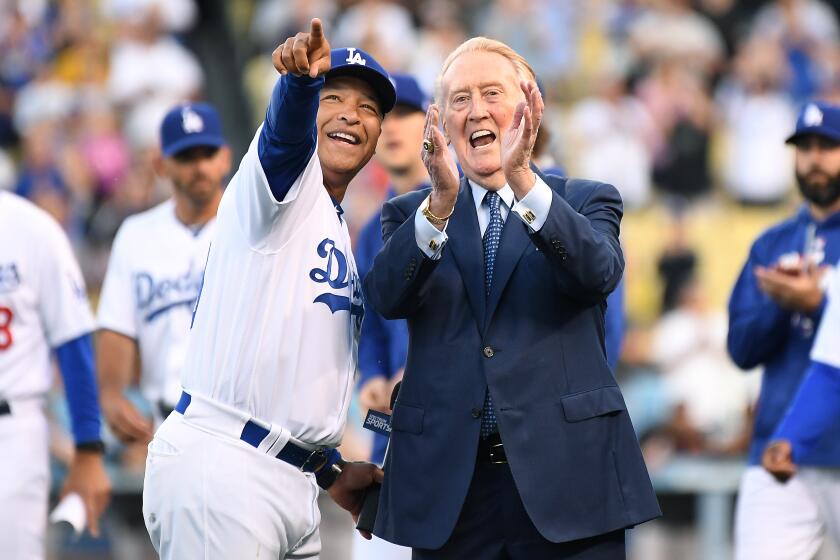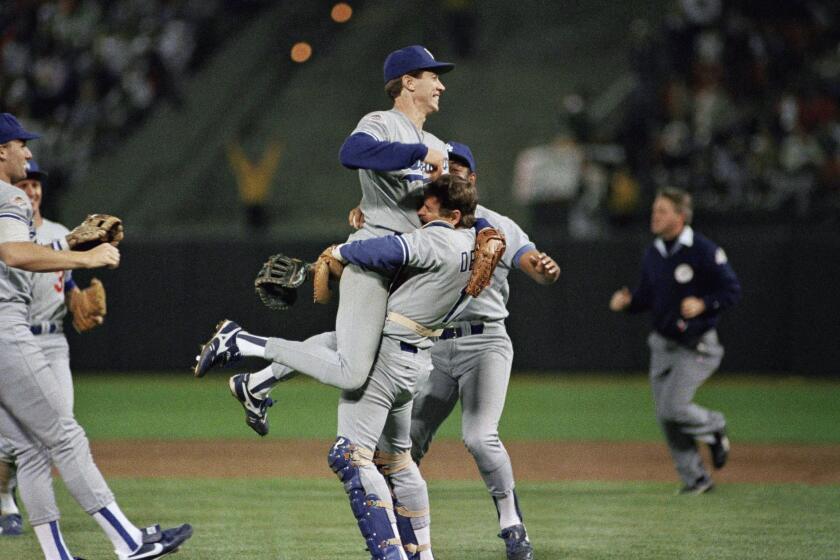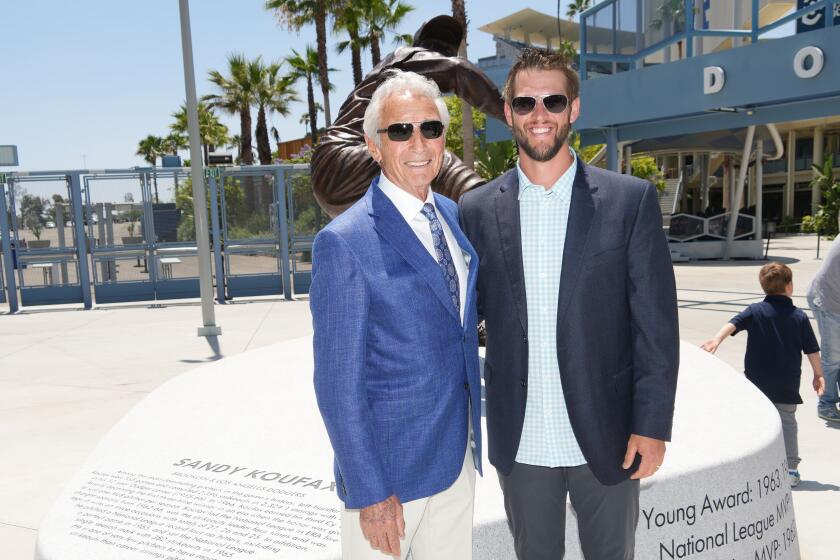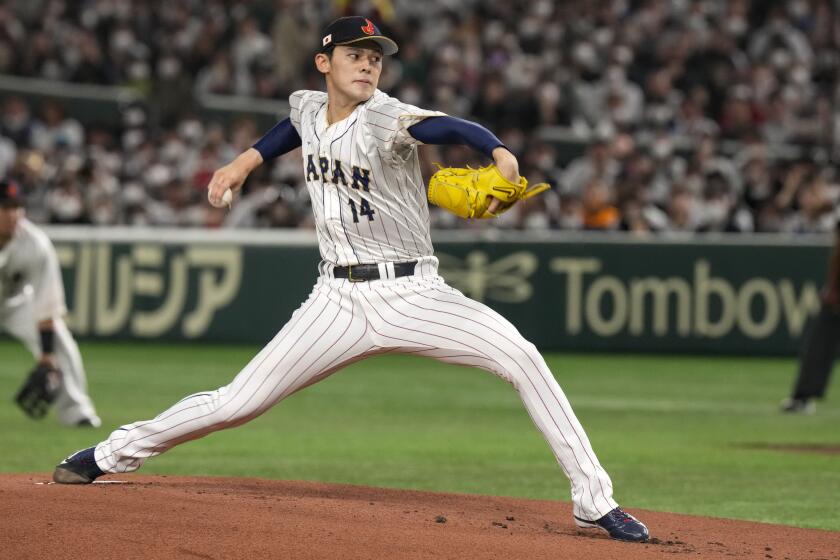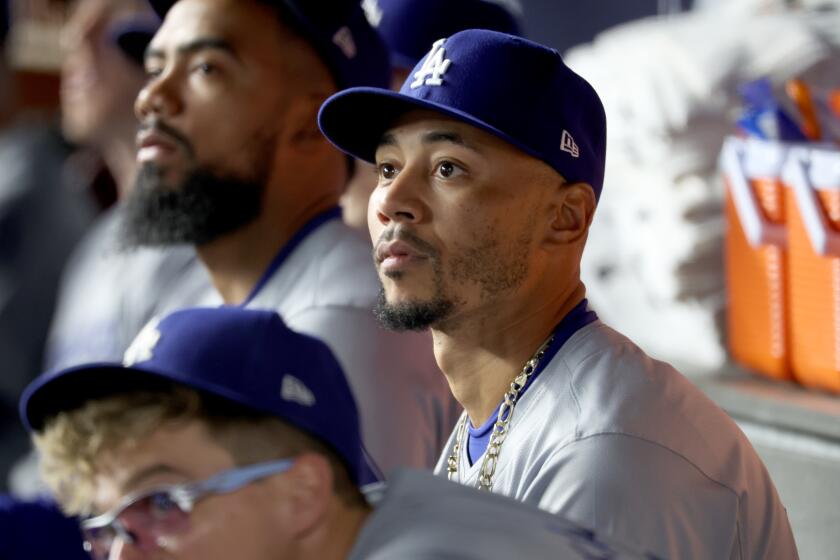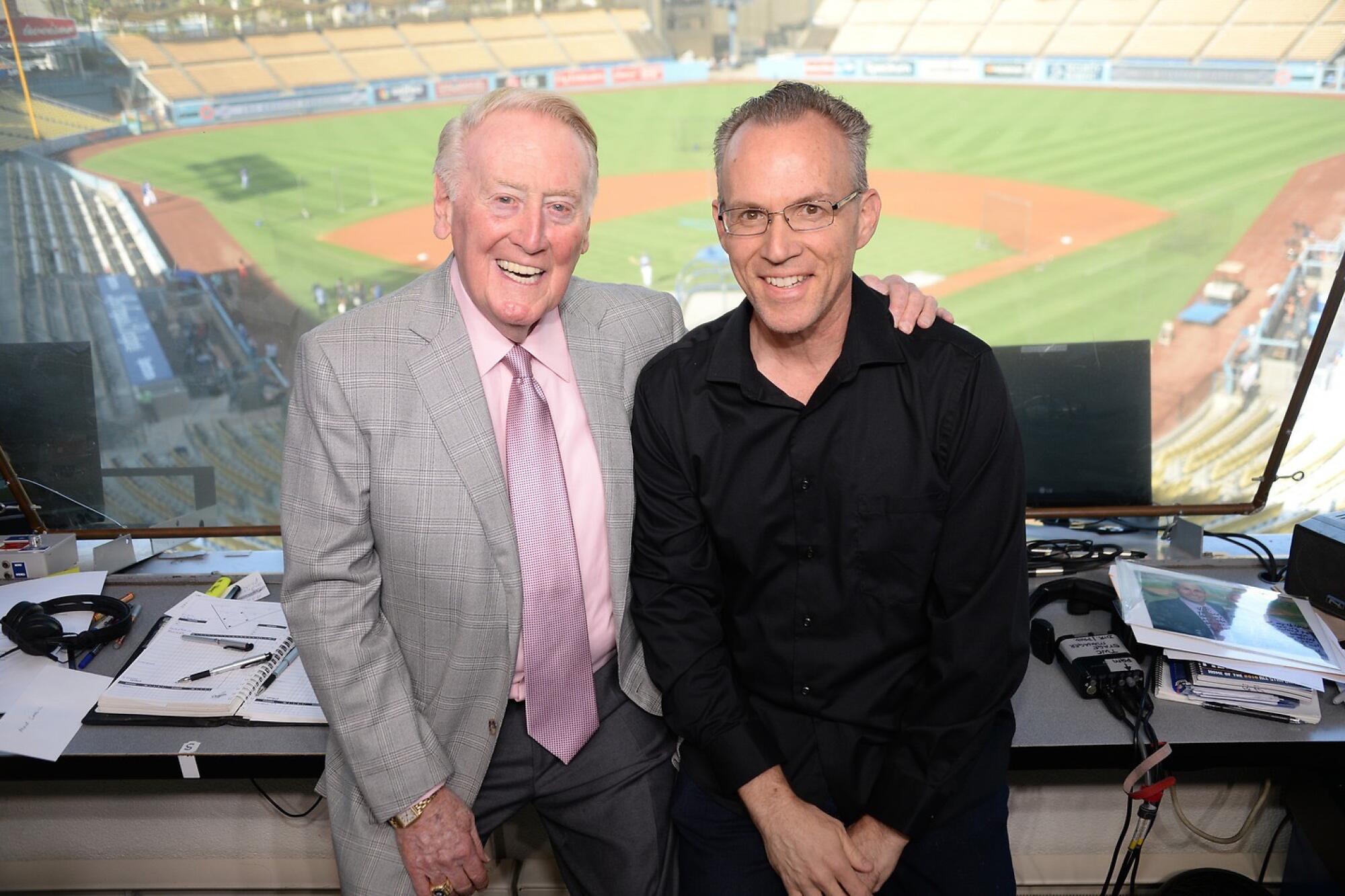
He was struggling to walk, battling to talk, fighting to think.
But he never forgot the Dodgers. He couldn’t forget the Dodgers.
In the first days following surgery to remove two brain tumors, Dodgers team historian Mark Langill was having trouble recalling everything but the legacy that lives permanently in the deepest blue part of his soul.
“The strangest thing,” Langill said. “Ninety percent of my brain was temporarily affected, but the Dodger part never went away.”
During a walk around the Huntington Hospital hallway, an orderly asked him his room number and, thanks to the Dodgers, he remembered.
It was Ted Sizemore’s Dodger rookie number, combined with Sizemore’s number when he returned to the Dodgers seven seasons later.
4105
As he continued his recovery, every day melting into the next, nurses would try to keep him alert by writing each new date on a grease board.
Thanks to the Dodgers, he never lost track.
Somebody wrote, May 1, and Langill immediately said, “Brooklyn Robins against the Boston Braves, 26 innings in 1920, longest game in major league history.”
On May 5 he said, “Russell Martin’s debut in 2006.”
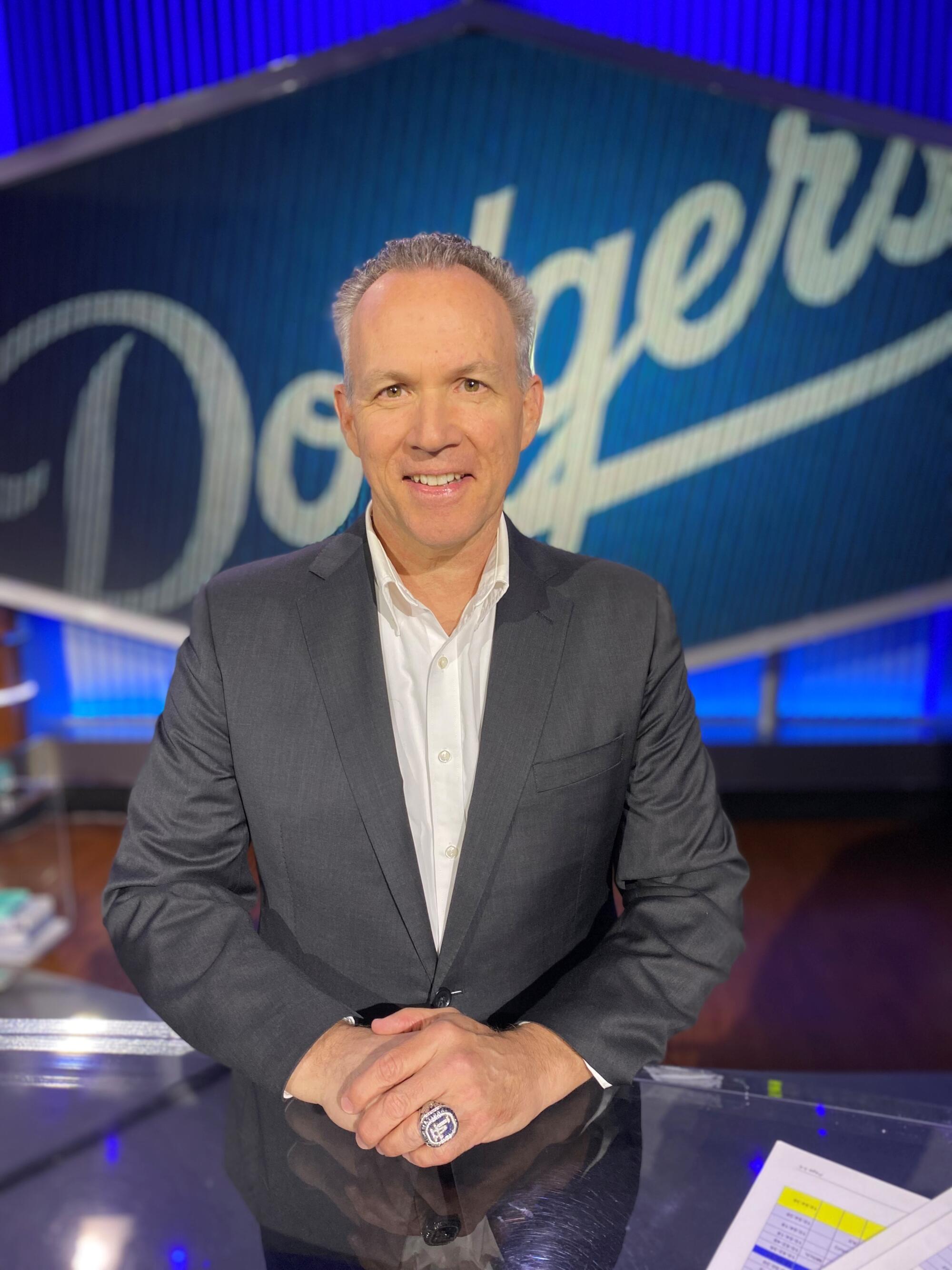
On May 7 he said, “Russell Martin’s first home run against the Milwaukee Brewers in 2006.”
Nearly two months later, Langill is out of the hospital and fighting to beat brain cancer with the staunchest of allies.
His sword is Dodger memories. His shield is Dodger highlights. He knows more about Dodger history than any living human, and that history is carrying him through the rocky ground where everything else is uncertain.
“All this obscure Dodger stuff stayed in my head,” said Langill, 59. “Whatever they cut out, they didn’t cut that.”
This reliance on Dodger landmarks actually began on April 25, the day he was rushed to the hospital after behaving unsteadily at Dodger Stadium.
As he lay in the speeding ambulance, all he could think about was, it was flag day!
“Who can forget that?” he said. “April 25, 1976, the most famous play in the history of Dodger Stadium was made by an opposing player, Rick Monday saving the American flag.”

Later that day, while being inserted into the MRI machine, he assured the technicians that he was being calmed by the memory of … Andy Etchebarren?
“The 1966 World Series, he played for the Baltimore Orioles, he was the last man to bat against Sandy Koufax, and…he won the starting job in the spring because Dick Brown had a brain tumor,” Langill explained. “I survived the MRI by playing baseball brain tumor trivia.”
And when he learned that his surgeon would be Dr. Celene Mulholland? He never again forgot that name because, of course, Terry Mulholland pitched for the Dodgers in 2001 and 2002.
Only Langill, it seems, would remember a celebrated neurosurgeon because of a pitcher who graced the Dodgers with a 1-1 record and 6.60 ERA.
“I can’t help it,” he said with a chuckle. “It’s who I am.”
It’s what he’s been for the last 30 years, a delightful human trove of information that constantly shares with players and fans alike. A former sports writer, Langill began working in the team’s publications department before spending the last 22 years as baseball’s first official team historian, a role which puts him at the forefront of the team’s powerful connection between its present and past.
Orel Hershiser put on a pitching display over the final two months of the 1988 season that should never be forgotten. And yet, it has increasingly been overlooked.
“Mark can talk about something that happened in 1965 as easily as something that happened yesterday,” said Lon Rosen, Dodgers executive vice president and chief operating officer. “He brings great comfort to everyone because you can ask him anything and he always has the right answer.”
If a former player wants to relive glory days, he calls Langill, who derives joy from assisting Dodgers both famous and anonymous, from the day of their retirement until their death. He has provided memories and memorabilia for many memorial services and even served as an impromptu eulogizer at Willie Davis’ funeral.
“Mark has always been my number-one asset to continue to understand the greatness of the Dodgers,” said Orel Hershiser, former pitcher and current broadcaster. “He brings another level of expertise and passion with the details he remembers at a moment’s notice.”
If a fan wants to embrace a special memory, they are also directed to Langill, who loves to print out ancient remnants to remind folks of their happiest Dodger moments.
Legendary Dodgers pitcher Sandy Koufax thanks 46 people during a 10-minute speech at the unveiling of his statue at Dodger Stadium on Saturday.
“He is everybody’s brother, father, cousin, a trusted family member who remembers everything and is happy to share this knowledge with everyone,” said Rosen.
In fact, in his last game at Dodger Stadium before falling ill, Langill hosted an 80-year-old woman whose first game was at Ebbets Field in 1954 when Don Newcombe was pitching.
Langill surprised her by printing out the box score from that actual game, handing it to her, then they both basked in her wonder at reliving her childhood.
“Suddenly she’s 10 years old again and sitting with her grandfather,” Langill recalled. “She said it was raining that day, and she talked about what it was like to be a 10-year-old at her first game and … to actually see her relive all that was priceless.”

A few days later Langill was spinning more great tales for new Dodger employees during a stadium tour when he became unsteady. He ended up at Huntington Hospital, where several days later Mulholland pitched a perfect game in removing two tumors the combined size of a lemon.
Before the surgery, Langill prepared himself by watching a laptop video of Game 2 of the 1974 World Series between the Dodgers and the Oakland Athletics.
“That’s the one game in that series that the Dodgers won, and it was won by my first favorite Dodgers team with my all-time favorite Dodger Jimmy Wynn,” Langill said. “I figured, if I’m going to go out, I’m going to go out my way.”
He also remembered that it was the World Series where then-third-base coach Tom Lasorda wore two different cleats because he had two different shoe contracts.
“Those are the little stories that make Dodger history so special,” Langill said.
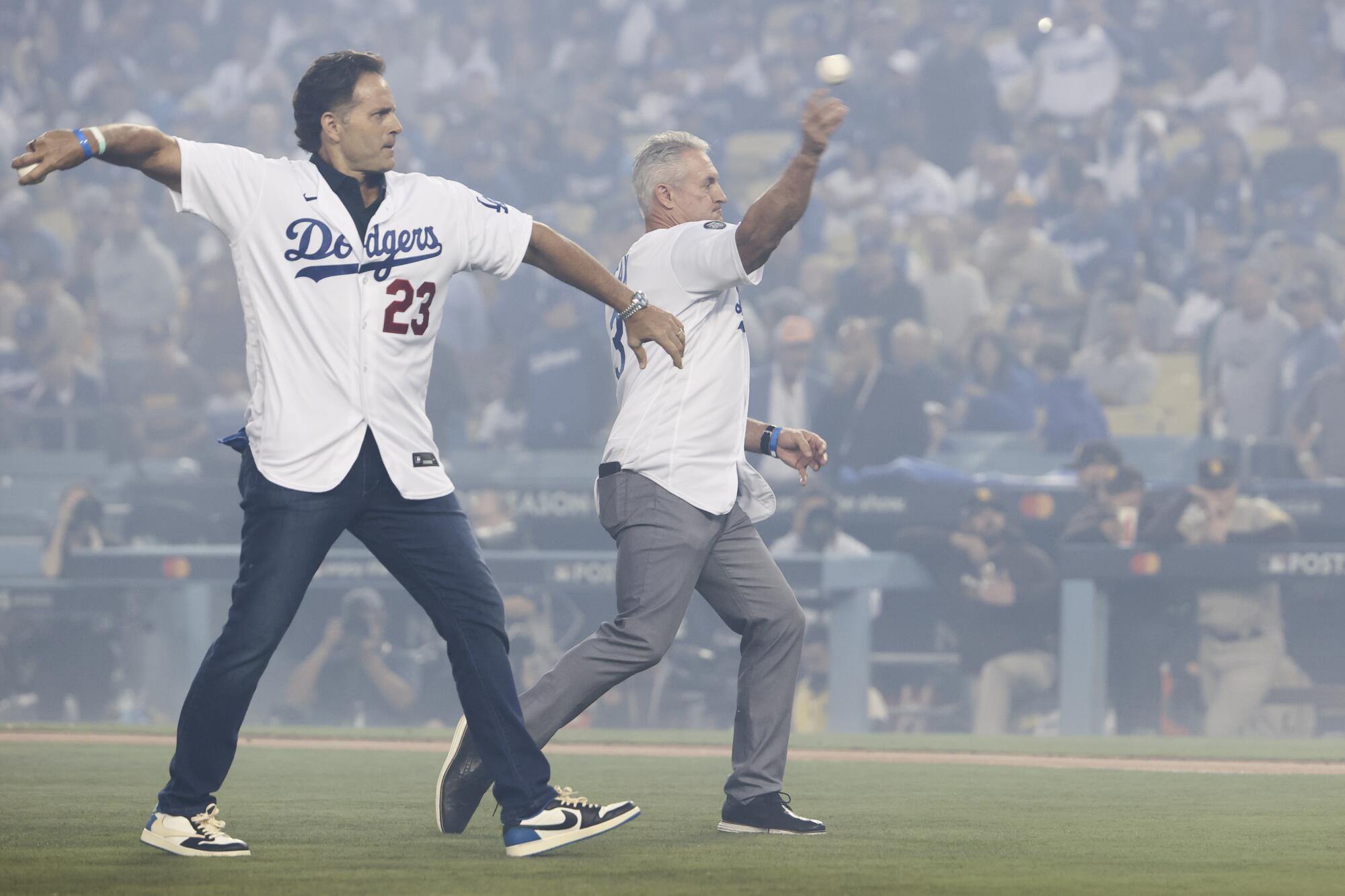
As the surgery approached and it came time to seek peace, Langill kept thinking about Gary Cooper’s quote while portraying Lou Gehrig, “All the arguing in the world can’t change the decision of the umpire.”
He explained, “Some people in that situation rely on Scripture. I also rely on ‘Pride of the Yankees’.”
Throughout the ordeal, his recovery buoyed by his longtime partner, Patty Hirata, and registered nurse nephew Michael Rayala, Langill quickly bonded with various hospital workers through the Dodgers. He doesn’t remember much about the physical details of his stay, but he remembers discussing Shohei Ohtani with one orderly and then traveling back down memory lane with his first physical therapist.
“Mark has always been my No. 1 asset to continue to understand the greatness of the Dodgers.”
— Orel Hershiser
“He said his earliest Dodger memory was when he was 4 years old and his mom took him to LAX and I knew exactly what he was talking about,” Langill said. “Oct. 23, 1957, Red Patterson arranged for a pep rally to welcome the team to Los Angeles.”
During his rehabilitation, while initially struggling with everything but his Dodger knowledge, Langill was strengthened by the way it connected him with his uncomfortable surroundings.
“It’s like knowing 100 languages,” he said. “You can talk to anybody at any age if it involves the Dodgers.”
During his many years with the Dodgers, he had made many of those unique connections, his constant outreach making him arguably the franchise’s most important public representative.
There was the longtime Brooklyn Dodgers fan who was on his deathbed and wanted to hear one more Dodger story before he passed. His daughter handed the phone to Langill, who proceeded to take the man on an audio tour of all the Brooklyn Dodger memorabilia spread around the stadium.
“I told him, ‘We’re here for you,’” Langill recalled.
Then there is his annual reminder to Eric Karros every May 23.
The Dodgers, wounded and worried, pretty much needed a miracle to shake them from their slumber.
“Happy Stan Belinda Day,” he will tell him because, on that day in 1992, Karros established himself as a future star by hitting a three-run walk-off homer against the Pirates’ Stan Belinda.
You can look it up. Langill’s memory of Dodger history is bulletproof.
“With him, we never need a fact checker,” said Rosen. “He’s right every time.”
“He’s basically become the caretaker of Dodger history,” said Karros of Langill. “Anything you want to know, he’s your guy.”

Then there was the story of Roy Gleason, a former outfielder who doubled in his only major-league plate appearance for the Dodgers in 1963. After that season Gleason was sent to Vietnam and never played major league baseball again, ending his career with that one at-bat, always wondering if anybody on the Dodgers remembered.
Langill remembered. Langill always remembers. And when he heard that Gleason was feeling disconnected from an organization that indeed had seemingly forgotten him, Langill invited Gleason to Dodger Stadium in the summer of 2003.
Once there, Langill accompanied Gleason to a wall that contains most of the names on the Dodgers’ all-time roster. In a scene that brought both men to the verge of tears, Gleason’s name was there.
“I was surprised that anyone in the organization even remembered my name,” said Gleason recently. “But Mark took the time to go into the Dodger archives and research my history.”
Later that season, Gleason threw out the first pitch and was surprised with a 1963 World Series ring.
“The best night of my life…a night I will never forget,” said Gleason. ‘And it all happened because of Mark Langill.”
Roy Gleason, the Dodger who batted 1.000 before being drafted and going off to Vietnam, is back in the fold
This season Dodger history will have a new entry, a new landmark, a new hero, the date of June 17.
“That’s the anniversary of the first regular season ‘Freeway Series’ game between Dodgers and Angels,” Langill recalled. “Dodgers won on Todd Zeile’s walk-off home run against Troy Percival.”
Well, yes, but this is about something bigger.
June 17 should be forever known as the day Mark Langill not only recorded Dodger history, but made it.
It is the day he returned to work.
More to Read
Are you a true-blue fan?
Get our Dodgers Dugout newsletter for insights, news and much more.
You may occasionally receive promotional content from the Los Angeles Times.

